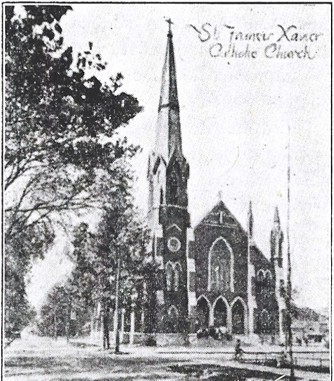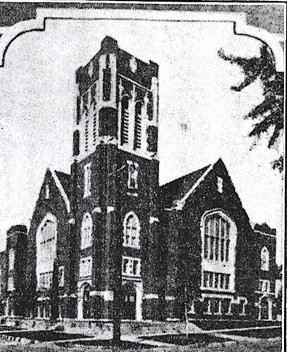|
Chapter 29
The Growth of the Churches
Bishops or no bishops
At the close of the nineteenth century three of the largest denominations -- the Methodists, the Roman Catholics and the Lutherans -- had congregations in most of the 99 counties in the State.
Other large denominations, but not so extensively organized were the Baptists, the Presbyterians,
the Congregationalists, the Christians, and the United Brethren.
 |
|
 |
| |
|
|
Typical Catholic Church of the
nineteen twenties |
|
Typical Protestant Church of the
nineteen twenties |
Still smaller denominations were the Episcopalians, the Adventist, the Universalist, the Reformed Church, Church of Christ, Evangelicals, the Mennonites, the Reorganized Latter-Day Saints, the Quakers or Friends, the Christian Scientists, the Unitarians, and the Jews. The newest groups are the Nazarenes and Jehovah's Witnesses. In all upwards of 50 different denominations now have congregations in Iowa.
With respect to government, all the denominations may be divided into two classes: those which have bishops and those which have not. The Catholics, the Episcopalians and the Methodists have such officers, whereas most of the others have....
Page 107
�.not. The bishops are supervisory officers like the superintendents of the schools. The denominations having no bishops believe that each congregation should be allowed to rule itself and therefore there is no need for bishops.
For purposes of gathering statistics, charity, mutual aid and encouragements, the various denominations form dioceses, presbyteries, synods, associations or districts, which hold larger meetings called conferences, of conventions, not unlike civil legislatures and congresses.
Church and state are separated
The ministers and other officers of the churches in the United States are paid by the church members and not, like the teachers in public schools, by the state. In some European and South American countries the salaries of the ministers are paid directly or indirectly by the state. In the countries of these continents, church and state are said to be united. In Iowa, as in the other states of the United States, church and state are separated, and each citizen is free to join and support any church he pleases.
New church buildings
Some of the churches built before the Civil War are still standing and in use, but most of the earlier buildings have been replaced by more substantial structures of greater artistic beauty. A large number of churches and parsonages were built during the last quarter of the nineteenth century. In the country they were usually built of wood, it the cities of brick or natural stone. After each of the World War there was an era of church building. Architectural styles changed, especially after the second World War. Today Iowa has a large number of fine new church buildings.
The churches foster education
The last quarter of the nineteenth century was one of great interest and activity in church work. Nearly all the denominations were growing. Sunday schools, academies and colleges were established with enthusiastic support of most of the denominations. The Reformed Church, the Lutherans and especially the Catholics maintained elementary schools. And the children who enrolled in the parochial �.
Page 108
�. schools frequently attended the public high schools after graduation from the elementary parochial schools.

Penn College, Oskaloosa. About 1870 |
Educating the heart
Nearly all the denominations had Sunday schools. Some of these schools had classes for both adults and children. Often the children's classes were taught by the fathers, mothers, sisters or brothers of the children.
Sunday schools gave the children an important part of their education. Often it was said at the public schools educated the head and the Sunday schools the heart. Like the public schools, the Sunday schools were graded and under the direction of superintendents. Children's Day came to be generally observed in the nineties by the congregations of some denominations.
A few denominations had special kinds of religious schools. The Adventists had Sabbath schools on Saturdays instead of Sunday schools on Sunday. Some foreign denominations in addition to Sunday schools had, when the public schools were not in session, vacation schools where both religion and the foreign language of the denomination were taught.
Wider interest in religious vacation schools came in the present....
Page 109
....century. Many congregations of the various denominations now conduct vacation schools.
Churches promote higher education
One of the finest contributions which the churches have made to culture in Iowa was the higher church schools: academics, normal schools, and colleges. With the exception of the State University, these were at first the only higher institutions of learning in the State. They became to some extent models for the State colleges. There are today (1956) 21 four-year senior church colleges and several two-year junior colleges in Iowa.
Prohibition, Americanization, and hospitals
The churches in other ways made their influence felt. A large number of church people were Prohibitionists. The growth of the Prohibition movement in Iowa was consequently largely due to church people.
It was also the churches that began the work of Americanization among the foreigners. While this work was chiefly of a religious character, it also served to bring about generally sympathetic relations between foreigners and natives.
The churches were pioneers in the building and maintaining of hospitals. Early Iowa hospitals were generally conducted by some order of Catholic sisters, and some of the best hospitals in the state still are. Recently Methodists, Presbyterians, and Lutherans have also built and are maintaining hospitals. Lastly have come some county and municipal hospitals, and a State hospital at the Iowa State University, which is one of the largest and best equipped hospital in the whole country.
Missions and international good will
The missions of the Churches among the Indians and in foreign countries are another noteworthy feature of church work. We have already noted Catholic missionaries among the Potawatomis and Presbyterians among the Winnebagoes and Meskwakies. In the eighties there was for a short time an Indian school at West Branch, managed by the Quakers. The foreign missions gave the members of the churches a special interest in the relations between other countries and the United States, thereby promoting international peace and good will among the peoples of the Earth.
Page 110
Adherents of three world faiths
At the beginning of the present century the leading churches in Iowa were the Methodist, the Catholic, the Lutheran, the Christian or Disciples, the Presbyterian, the Baptist and the Congregational. In 1925 the census takers in Iowa counted only adherents of the larger world faiths. Of Iowa's two and a half million people about 12,000 declared themselves to be of the Jewish faith, more than a third of a million Catholic, and nearly two million Protestant. The rest are listed as of unknown faith, but many of them undoubtedly attended some church.
Questions and Exercises: What is a bishop? Define congregation, denomination, synod, and dioceses. How are the pastors of the Churches paid in the United States? In some European countries? How have the churches fostered general education? What are parochial schools? Vacation schools? What is the length in years of the course in a senior college? In a junior college? What churches have built hospitals? Name the three world faiths, having at least 12,000 adherents, represented in Iowa today?
|